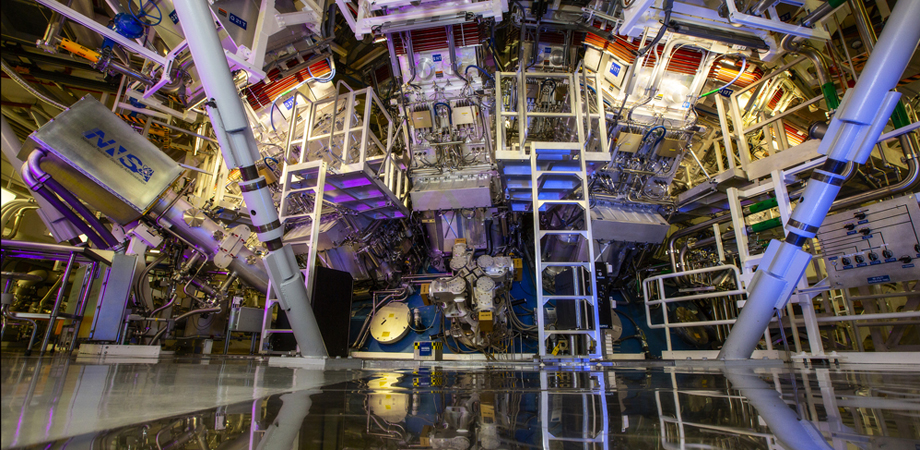LASE plenary talks explore new laser-based tools, high-Q metasurfaces, and photonic quantum systems

In August 2021, a record-breaking shot with 1.3 megajoules of fusion yield was achieved on the National Ignition Facility (NIF) at Lawrence Livermore National Laboratory (LLNL). This experimental result, decades in the making, was a significant breakthrough for laser-driven inertial fusion.
At the LASE Plenary and Hot Topics session at SPIE Photonics West in January, Tammy Ma, the Advanced Photon Technologies Program Element Leader for High-Intensity Laser High Energy Density Science at LLNL, discussed how these game-changing results are laying the groundwork to explore laser inertial fusion as a path for clean energy and energy security.

Lawrence Livermore National Laboratory physicist Dr. Tammy Ma. Credit: LLNL
Moving into the terahertz domain
"Right now, the high-power, ultrafast sources in the THz domain that we developed in the last few years are a unique ‘niche' development that I find most exciting," says Clara Saraceno, who leads the Photonics and Ultrafast Laser Science (PULS) group at Ruhr University Bochum. "I find it really interesting to see what new applications will unravel or what ‘old' problems these ‘new' laser-based tools could help to solve."
As part of the LASE Hot Topics session, Saraceno discussed how the demonstration of table-top sources of few-cycle THz radiation with extremely high average power has been enabled by progress in high-power ultrafast laser sources.
Saraceno notes that research and development of new laser sources — and more widely, other light-based sources — is critical for solving technologically and scientifically difficult problems. This doesn't only relate to the THz domain, but to most applications in other regions of the electromagnetic spectrum as well.

Prof. Clara Saraceno, who leads the Photonics and Ultrafast Laser Science (PULS) group at Ruhr University Bochum. Credit: RUB, Marquard
"In many cases, sources research is underestimated in its difficulty and usefulness by people doing the applications," says Saraceno. "This means that more ‘blue-sky' research (where ‘real-world' applications are not immediately apparent) in exclusive source development should be made possible, and that more collaborative work between source developers and application experts should become the norm."
Saraceno believes the key for continuing the advance of high-power ultrafast laser technology will be in the combination of technologies, meaning having more ‘hybrid' systems to reach a desired goal. She would like to see more collaboration between laser source experts and applications, and more academic work in this area.
"Most importantly," says Saraceno, "I would like to see these extremely high average power systems be more often brought to applications where they can shine."
Photonic quantum systems
Plenary speaker Michael Kues, head of the research group "Photonic Quantum Technologies" at Leibniz University Hannover, reviewed approaches for the efficient realization of quantum frequency combs in on-chip waveguide structures and micro-resonators.

Prof. Michael Kues, head of the research group "Photonic Quantum Technologies" at Leibniz University Hannover. Credit: LUH
"I would like to emphasize that the multi-mode nature of the photons' frequency degree of freedom, in the form of so-called quantum frequency comb systems, together with further exploration of elaborated manipulation elements, can be a powerful approach to develop scalable quantum systems for various application scenarios in communication, computing, sensing," says Kues. "From the side of technology, this approach is compatible with and can directly benefit from already developed state-of-the-art telecommunication devices and integrated photonic fabrication."
Kues adds that he would one day like to see further advancement of photonic quantum systems towards large scale solutions, capable of implementing and accelerating required computations in material research, drug development, climate models, and AI.
Lenses beyond limits
During her Hot Topics talk, Jennifer Dionne, Senior Associate Vice Provost of Research Platforms at Stanford University, shared how nanophotonics can address challenges in global health. Key to this work is her lab's recent development of high-quality-factor (high-Q) metasurfaces. These high-Q metasurfaces strongly localize light in the near field, while also precisely directing optical transmission to the far-field. Dionne described how these metasurfaces enable multiplexed and low-cost genetic screening and rapid antibiotic susceptibility testing of bacteria, including tuberculosis.

Jennifer Dionne, Senior Associate Vice Provost of Research Platforms at Stanford University. Credit: MSE/Stanford University
"I think metasurfaces hold enormous potential for future networks, spanning health, sustainability, and communications," says Dionne. "The useful information density of a network scales with both the number of elements and the number of connections. For optical networks, considerable effort has been devoted to miniaturizing photonic components, in order to increase the number of elements in the network."
With her lab's development of high-Q metasurfaces, an alternate strategy for scaling photonic networks is being created: increasing the number of connections between wavelength-scale components. Dionne points out that although the diffraction limit sets a bound on the number of optical elements that can be included in the network, there is no limit on the number of diffracted channels.
Producing multifunctional surfaces
"In the last 20 to 30 years, there has been enormous progress in the utilization of laser-based technologies, in particular using short and ultra-short pulsed laser sources, for addressing relevant scientific questions related with high-precision processing of materials as well as with the functionalization of surfaces, says Andrés Fabián Lasagni of TU Dresden and Fraunhofer IWS. "However, typical drawbacks for these technologies have been the high cost of the laser sources and the relatively low productivity." Lasagni notes that the situation is changing with the introduction of new high-power laser sources, which can significantly reduce processing times and production costs. However, this will only be possible if new optical systems and strategies are developed to manage these higher powers.

Andrés Fabián Lasagni of TU Dresden and Fraunhofer IWS. Courtesy of Andrés Fabián Lasagni
At TU Dresden, Lasagni is chair of the Large Area Laser Based Surface Structuring group, which focuses on the development of functional surfaces. At Fraunhofer IWS, he is director of the "Center for Advanced Micro Photonics," that strategically coordinates with activities at TU Dresden in various research fields such as photonic-based in-line monitoring and advanced laser micro structuring.
For his LASE Hot Topics talk, Lasagni provided an overview of laser-based fabrication methods and how they can be combined to produce surfaces with multi-functional surface properties. Also, how the combination of well-defined and periodic structural elements with different feature sizes can be used to increase the long-term performance of surfaces.
Karen Thomas is a contributing editor at SPIE. A version of this article appeared in the 2022 Photonics West Show Daily.
Related SPIE content:
Nuclear fusion: NIF's hall of mirrors may solve world's energy crisis
| Enjoy this article? Get similar news in your inbox |
|



